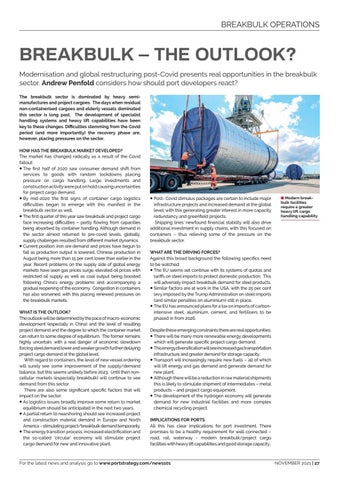BREAKBULK OPERATIONS
BREAKBULK – THE OUTLOOK? Modernisation and global restructuring post-Covid presents real opportunities in the breakbulk sector. Andrew Penfold considers how should port developers react? The breakbulk sector is dominated by heavy semimanufactures and project cargoes. The days when residual non-containerised cargoes and elderly vessels dominated this sector is long past. The development of specialist handling systems and heavy lift capabilities have been key to these changes. Difficulties stemming from the Covid period (and more importantly) the recovery phase are, however, placing pressures on the sector. HOW HAS THE BREAKBULK MARKET DEVELOPED? The market has changed radically as a result of the Covid fallout: 5 The first half of 2020 saw consumer demand shift from services to goods with random lockdowns placing pressure on cargo handling. Large investments and construction activity were put on hold causing uncertainties for project cargo demand. 5 By mid-2020 the first signs of container cargo logistics difficulties began to emerge with this manifest in the breakbulk sector as well. 5 The first quarter of this year saw breakbulk and project cargo face increasing difficulties – partly flowing from capacities being absorbed by container handling. Although demand in the sector almost returned to pre-covid levels, globally, supply challenges resulted from different market dynamics. 5 Current position: iron ore demand and prices have begun to fall as production output is lowered, Chinese production in August being more than 15 per cent lower than earlier in the year. Recent problems on the supply side of global energy markets have seen gas prices surge, elevated oil prices with restricted oil supply as well as coal output being boosted following China’s energy problems and accompanying a gradual reopening of the economy. Congestion in containers has also worsened, with this placing renewed pressures on the breakbulk markets. WHAT IS THE OUTLOOK? The outlook will be determined by the pace of macro-economic development (especially in China) and the level of resulting project demand and the degree to which the container market can return to some degree of equilibrium. The former remains highly uncertain, with a real danger of economic slowdown forcing steel demand lower and weaker growth further delaying project cargo demand at the global level. With regard to containers, the level of new vessel ordering will surely see some improvement of the supply/demand balance, but this seems unlikely before 2023. Until then noncellular markets (especially breakbulk) will continue to see demand from this sector. There are also some significant specific factors that will impact on the sector: 5 As logistics issues broadly improve some return to market equilibrium should be anticipated in the next two years. 5 A partial return to nearshoring should see increased project and construction material demand in Europe and North America – stimulating project/breakbulk demand temporarily. 5 The energy transition process, increased electrification and the so-called ‘circular’ economy will stimulate project cargo demand for new and innovative plant.
5 Post- Covid stimulus packages are certain to include major infrastructure projects and increased demand at the global level, with this generating greater interest in more capacity redundancy and greenfield projects. Shipping lines’ newfound financial stability will also drive additional investment in supply chains, with this focused on containers – thus relieving some of the pressure on the breakbulk sector.
8 Modern breakbulk facilities require a greater heavy lift cargo handling capability
WHAT ARE THE DRIVING FORCES? Against this broad background the following specifics need to be watched: 5 The EU seems set continue with its systems of quotas and tariffs on steel imports to protect domestic production. This will adversely impact breakbulk demand for steel products. 5 Similar factors are at work in the USA, with the 25 per cent levy imposed by the Trump Administration on steel imports (and similar penalties on aluminium) still in place. 5 The EU has announced plans for a tax on imports of carbonintensive steel, aluminium, cement, and fertilisers to be phased in from 2026. Despite these emerging constraints there are real opportunities: 5 There will be many more renewable energy developments which will generate specific project cargo demand. 5 This energy diversification will see increased gas transportation infrastructure and greater demand for storage capacity. 5 Transport will increasingly require new fuels – all of which will lift energy and gas demand and generate demand for new plant. 5 Although there will be a reduction in raw material shipments this is likely to stimulate shipment of intermediates – metal products – and project cargo equipment. 5 The development of the hydrogen economy will generate demand for new industrial facilities and more complex chemical recycling project. IMPLICATIONS FOR PORTS All this has clear implications for port investment. There promises to be a healthy requirement for well connected – road, rail, waterway - modern breakbulk/project cargo facilities with heavy lift capabilities and good storage capacity..
For the latest news and analysis go to www.portstrategy.com/news101
NOVEMBER 2021 | 27
















